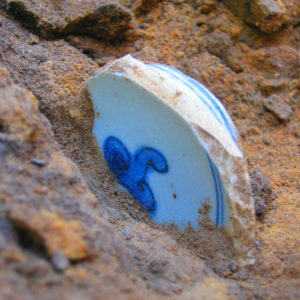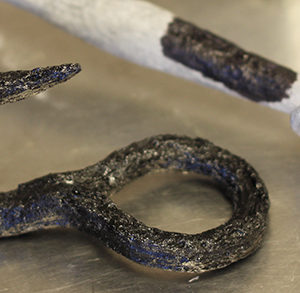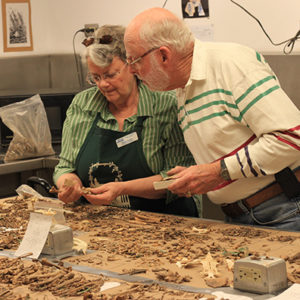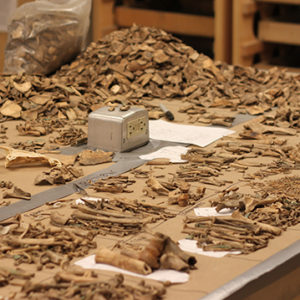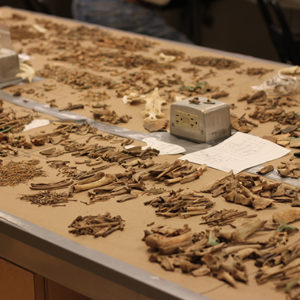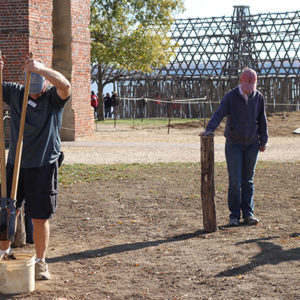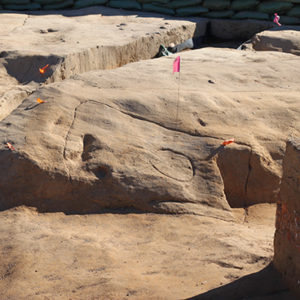With winter a month away, the Jamestown Rediscovery archaeologists are preparing the James Fort site for its annual respite from their shovels and trowels. Large sections of the site have been backfilled but the 1608 church excavation area remains open as does the site of a mud and stud structure to the north. Work will continue at these two sites until cold weather forces the archaeologists indoors to write reports on this year’s findings.
Using the 12-foot interval established by the discovery of the 1608 church’s previously-found postholes, the archaeologists believe they have found a ninth posthole at the western extent of the church excavations. The soil stain isn’t as well defined as the others found before it because the earth in this section of the fort has been disturbed many times over the centuries. The most obvious of these disturbances was the creation of the Confederate fort that sat on a large portion of James Fort’s footprint. In 1861, enslaved workers removed dirt from the area where the 1608 church once stood and used it to construct the earthworks that would protect the Confederate troops and artillery to be stationed there. There is concern that the other yet-to-be-discovered church postholes forming its western half might be similarly damaged or gone altogether. Now that they have found the 1608 church, the archaeologists are selecting the next section to excavate based on where the remainder of the church should be rather than continuing their sequential dig of neighboring squares in the area.
At the other excavation site a few yards to the north, most of the site has been backfilled to preserve the fort layers from the elements above. Before filling the area with soil, a protective tarp is first laid over the whole of the excavations. By protecting the early-17th-century layers with the tarp and several feet of dirt, the Jamestown Rediscovery team is allowing future generations of archaeologists—perhaps armed with more sophisticated equipment or guided by new knowledge—to study the evidence themselves.
Two sections of the northern excavations have been left unfilled. Excavations are wrapping up on two wall segments of a fort-period structure along the western edge of this area. Unfortunately this is all that remains of the building because the rest of the footprint was destroyed during the construction of a home built some 50 or 60 years later. That home, thought to have been burned during Bacon’s Rebellion, had a largely-intact cellar, the depth of which insured that the archaeological remains of the earlier building were largely wiped out. These two wall segments are remarkable for the soil type that fills the trenches where the walls once stood. The soil is of a completely different type than that on either side of the trenches as evidenced by a very obvious color difference. This soil is similar to that which fills the wall trenches of two nearby fort-period structures (for more on the soil type and a possible explanation, please see October’s dig update).
Excavations of sections of the trenches led to the discovery of a large amount of charcoal and burnt wood underneath the unusual soil layer. There is some thought that these are the remains of two distinct buildings, one which succumbed to a fire (perhaps the January 1608 fire that destroyed much of the fort) and another, built exactly on the same spot, using the same wall trenches for its foundation. During the excavations of these trenches, sherds of a Border ware pipkin and a small Chinese porcelain bowl were found.
To the east of this structure is the other section of the area which has yet to be backfilled. Here, a mud and stud structure will continue to be excavated when warm weather arrives next year. The archaeological remains have been carefully covered to preserve them during the winter months.
 In the conservation lab, curators and volunteers are sorting through the mountains of animal remains found in the 1608 well. Thousands of bones of fish, rodents, birds, deer, turtles, and other creatures have to be sorted, counted, and cataloged before entering the artifact vault for storage. Some of the bones have turned green due to their proximity to copper objects during their 400 years underground.
In the conservation lab, curators and volunteers are sorting through the mountains of animal remains found in the 1608 well. Thousands of bones of fish, rodents, birds, deer, turtles, and other creatures have to be sorted, counted, and cataloged before entering the artifact vault for storage. Some of the bones have turned green due to their proximity to copper objects during their 400 years underground.
The conservation team is continuing its work on iron objects found in the well. Air abrasion is one method conservators use to remove corrosion products from metal objects found at James Fort. The air abrasion tool acts as a mini sandblaster and projects a fine aluminum oxide powder at an object using pressurized air. The fine tip and adjustable pressure make the air abrader a good choice when dealing with delicate or compromised objects. Another method of corrosion removal for iron objects is electrolysis. Electrolysis is the process of running an electric current through an object in order to effect a chemical reaction. In this case, the metal object is connected to a current via a small metal clip and placed in a basic solution of electrolytes. Over the course of several weeks, the flow of electrons in the corrosion process is reversed, and the corrosion products are removed. This method only affects the side of the object that is facing a sacrificial stainless steel plate. Portions of the plate are eaten away during the reaction. Before these or any other conservation methods are used, metal objects are first x-rayed. X-rays allow the conservation team to see beneath the corrosion in order to determine how much of the original metal remains. For those objects with little or no remaining original metal, electrolysis is not used for fear of damaging what remains.
Once enough of the corrosion has been removed, the object is submerged in deionized water for a number of days to make it chemically neutral and thus resistant to further corrosion. The object is then submerged in a manganese phospholene solution to test for any corrosion residue. Any remaining residue turns red once the object is placed in the solution, allowing the conservators to focus on the trouble spots. Michael Lavin, Senior Conservator for the Jamestown Rediscovery Project, has observed that manganese phospholene also causes high-carbon iron portions to stand out as a darker color against the normal iron. Blacksmiths of this era were obviously aware of the increased strength of high-carbon iron versus normal iron as many of the objects in the Jamestown Rediscovery collection have high-carbon iron inserts at the tools’ pressure points. These strengthening infusions were invisible to the naked eye before the manganese phospholene was applied. Finally, after all of the corrosion products have been removed, a coating of tannic acid is applied to all surfaces of the object. Tannic acid reacts with the iron to produce a protective coating, inhibiting the development of future corrosion.
related images
- 17th-century Chinese porcelain bowl found in the wall trench excavations
- An iron artifact after tannic acid application
- An iron hook after being completely treated with tannic acid
- Curatorial Assistant Merry Outlaw and volunteer Fritz Mueller examine some of the bones.
- Some of the bones were turned green because they lay buried close to copper objects over the last 400 years.
- Another view of the well bones. The large pile at the far end consists of sturgeon remains.
- Bones from the 1609 well
- Archaeologist Dan Smith digs holes for posts that will represent a building excavated in 2007. The building sat just inside the fort’s eastern palisade.
- Border ware pipkin sherd
- One of the 1608 church’s postholes, marked by a pink flag
- Testing the deionized water solution to see if the metal object is neutrally charged



